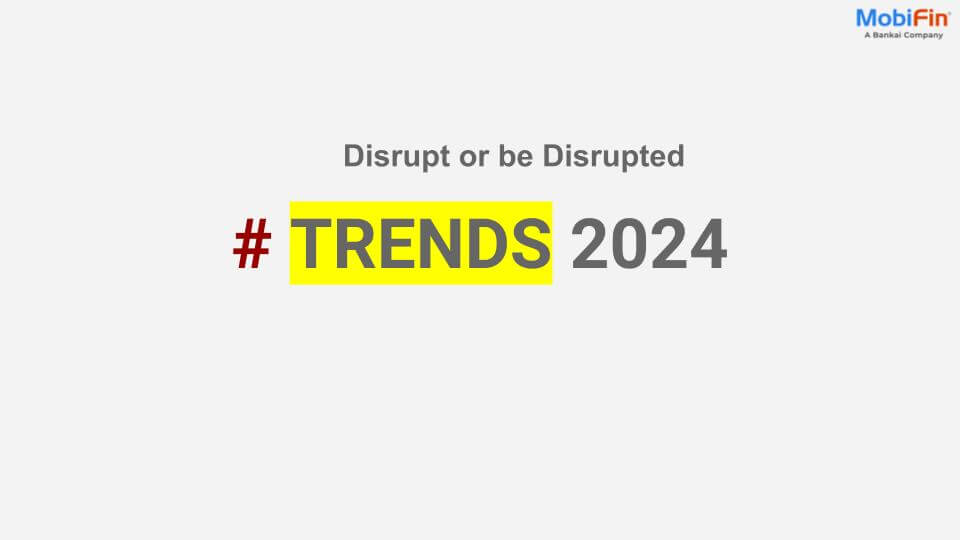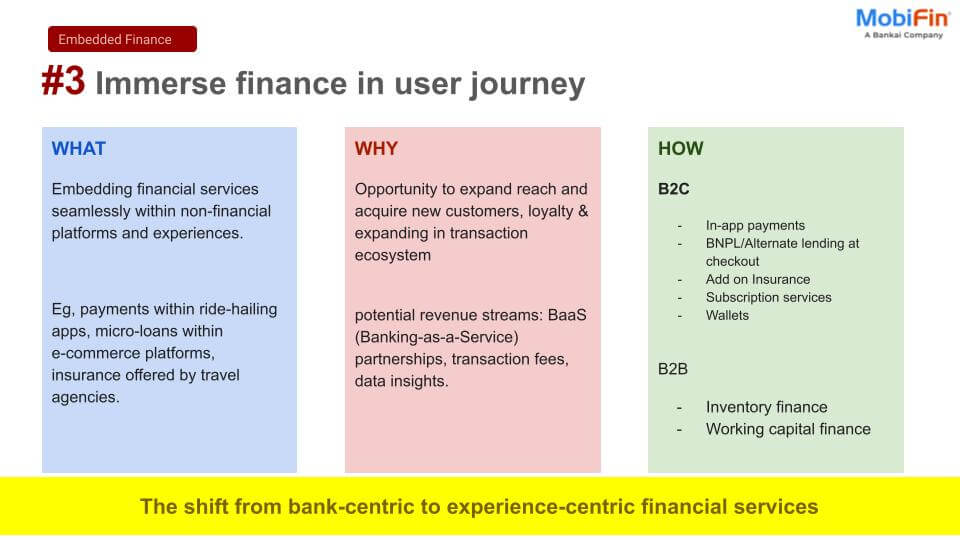But how do banks achieve this? By leveraging advanced AI technologies that analyze customer behavior across multiple touchpoints – mobile apps, web portals, and physical branches – to deliver highly relevant and timely recommendations, creating a seamless experience.
In this content, we will explore how AI is reshaping omnichannel digital banking platform, focusing on three key areas: personalized product recommendations, real-time financial insights, and consistent customer experiences across all channels.
AI technologies are not just transforming banking but also deepening customer loyalty and engagement, paving the way for a future of hyper-personalized financial services through:
Personalized product recommendations for enhanced customer engagement
- Proactive product offerings driven by past transaction history
- Tailored product offers based on customer life stages and needs
- Cross-selling and up-selling opportunities using predictive models
Real-time financial insights and proactive alerts for customers
- Personalized spending alerts based on user behavior patterns
- Budgeting and saving suggestions driven by data analytics
- Notifications for account updates, bill reminders, and investment opportunities
Omnichannel consistency and seamless customer experience
- Seamless transition across banking channels
- Personalized chatbots and virtual assistants powered by AI
- Prearranged in-branch experiences based on digital interactions
By integrating artificial intelligence into omnichannel software for banking, financial institutions can analyze customer data in real-time, predict future needs, and deliver highly relevant experiences across every interaction point. The main use cases of AI-driven hyper-personalization and how it is transforming the customer experience in modern banking are pivotal to understanding the future of the industry, as seen below
1. Customized product suggestions for boosting customer engagement
Banks no longer rely on broad marketing strategies. AI is reshaping the landscape by analyzing customer data to offer targeted and personalized financial products. This approach also increases engagement and fosters trust and loyalty as customers receive services that align with their specific needs.
Proactive product offerings driven by past transaction history
AI-driven hyper-personalization begins with analyzing a customer’s transaction history. Every purchase, bill payment, and investment decision gives banks valuable insights into a customer’s behavior. AI algorithms comb through this data to detect patterns and identify relevant product offers.
For example, a customer who frequently spends on travel might receive personalized credit card offers with travel rewards, while someone who saves regularly could get recommendations for high-interest savings accounts or investment opportunities. This granular level of personalization enables banks to offer products that align perfectly with individual needs.
Tailored product offers based on customer life stages and needs
One of the standout features of AI in omnichannel digital banking is its ability to recommend products based on a customer’s life stage. Whether someone is looking to buy their first home, start a business, or plan for retirement, AI can analyze their financial habits and suggest the right products at the right time.
For example, a young professional might be offered student loan refinancing or budgeting tools, while a customer approaching retirement could receive advice on pension plans or wealth management services. This also improves customer satisfaction and positions the bank as a trusted financial advisor.
Cross-selling and up-selling opportunities using predictive models
Banks also use AI-driven hyper-personalization to identify cross-selling and up-selling opportunities. By examining customer data, AI can suggest complementary products that enhance the overall value proposition.
For instance, a customer who has just taken out a mortgage might be offered home insurance or an investment plan to build wealth over time. Predictive models can also determine when a customer might be ready for a credit limit increase or additional financial services, thereby boosting engagement and increasing revenue streams for the bank.
2. Instant financial insights and proactive customer alerts
One of the most significant benefits of AI-driven hyper-personalization is its ability to provide real-time insights and alerts that empower customers to make informed financial decisions. Instead of waiting for customers to reach out, AI can proactively guide them with helpful suggestions and warnings.
Personalized spending alerts based on user behavior patterns
AI enables banks to monitor and understand spending habits. Through omnichannel software for banking, AI can send personalized alerts when a customer is approaching their budget limit or is overspending in a particular category, like dining or shopping.
These real-time alerts help customers stay on track with their financial goals and avoid falling into debt. AI not only sends warnings but also suggests actionable insights, such as moving funds to a savings account or reducing expenses in certain areas.
Budgeting and saving suggestions driven by data analytics
Budgeting and saving can be challenging for many customers. AI simplifies this process by analyzing spending patterns and offering personalized budgeting suggestions. Through omnichannel digital banking, customers can receive tailored advice on how to manage their finances more efficiently. AI might suggest setting up automatic transfers to a savings account or recommend investing excess funds into a high-yield savings account or other wealth-building tools.
This level of personalized financial advice can help customers improve their financial well-being and long-term savings goals.
Notifications for account updates, bill reminders, and investment opportunities
AI also plays a vital role in sending timely notifications for account updates, bill reminders, and investment opportunities. By using data-driven insights, banks can proactively alert customers to upcoming bill payments, preventing late fees and ensuring financial health.
Moreover, AI can identify favorable investment opportunities based on market trends and customer profiles, encouraging customers to take action when it benefits them the most. These proactive notifications enhance the overall banking experience and reinforce customer loyalty.
3. Unified experience and seamless interactions across channels
In today’s competitive market, customers expect seamless and consistent experiences across all banking channels, whether on a mobile app, website, or in-branch. AI-driven hyper-personalization ensures that customer interactions are consistent and personalized, regardless of where they occur.
Seamless transition across banking channels
One of the primary benefits of omnichannel digital banking is that AI enables a seamless transition for customers between different banking channels. For example, a customer who begins a mortgage application on their mobile app can pick up where they left off when they visit a branch or use the website.
AI collects and analyzes data across all touchpoints, ensuring that no matter where a customer interacts with the bank, their experience is smooth and uninterrupted. This omnichannel approach reduces friction and improves overall satisfaction.
Personalized chatbots and virtual assistants powered by AI
AI-driven chatbots and virtual assistants are becoming standard in the banking industry. These tools can answer routine queries, such as checking account balances or transferring funds, while also offering personalized financial advice based on customer data.
By integrating AI into omnichannel software for banking, banks can ensure that these virtual assistants provide relevant, real-time information to customers, improving their overall experience. These tools are available 24/7, making banking more convenient for customers who expect immediate service.
Pre-arranged in-branch experiences based on digital interactions
AI’s influence extends beyond digital channels and into physical bank branches as well. By tracking a customer’s digital interactions, AI can prepare in-branch representatives to provide personalized services when a customer visits in person.
For example, if a customer has been researching mortgage options online, a branch representative can offer pre-approved loan options or additional advice during their visit. This consistency ensures that customers feel valued and understood, whether they interact digitally or face-to-face.
In conclusion, AI-driven hyper-personalization is transforming the way customers interact with banks, establishing a new benchmark for delivering personalized, seamless, and consistent experiences across all channels.
By harnessing the power of AI, banks can offer personalized product recommendations, provide real-time financial insights and proactive alerts, and deliver omnichannel consistency that meets the high expectations of modern banking customers. These innovations enhance convenience and build stronger, more loyal relationships.
AI simplifies customers financial journey, offers tailored solutions, and ensures they receive the most relevant services when and where you need them. For banks, the value lies in deeper customer engagement, greater satisfaction, and the ability to stay ahead in a competitive market.
The future of omnichannel digital banking has arrived—are you ready to embrace it?













